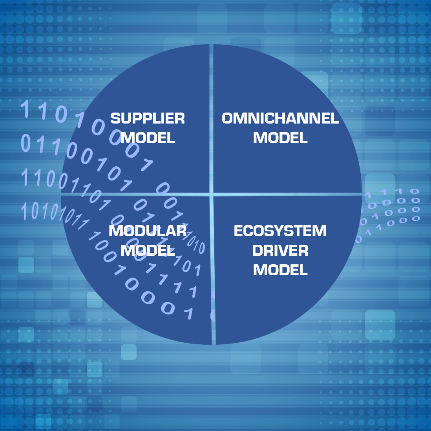Most business consultants agree the digital age requires organizations to transform into digital enterprises (i.e., enterprises that leverage big data to better meet their customers’ needs). For some enterprises, transformation may require an entirely new business model. According to McKinsey & Company analysts, Albert Bollard, Elixabete Larrea, Alex Singla (@alexsingla), and Rohit Sood, “Companies need to increase revenues, lower costs, and delight customers. Doing that requires reinventing the operating model. … For companies to build value and provide compelling customer experiences at lower cost, they need to commit to a next-generation operating model. This operating model is a new way of running the organization that combines digital technologies and operations capabilities in an integrated, well-sequenced way to achieve step-change improvements in revenue, customer experience, and cost.”[1]
This may sound radical and disruptive, but Deloitte analysts Andy Main and Rob Frazzini, explain, “Not all companies need to disrupt to be successful; in fact, focusing on disruption could distract them from achieving their real objectives. Metrics such as revenue growth, market share, earnings before interest and taxes, and lifetime customer value remain the hallmarks of corporate success, and digital strategies should align with these goals.”[2] Confused? You might take cold comfort in knowing you’re not alone. Several years ago, Arthur Cole (@acole602) wrote, “The race is on to transform today’s enterprise to a digital entity, which sounds like a reasonable goal until you stop to consider that no one knows exactly what a digital enterprise is.”[3] The confusion arises because every enterprise’s transformation journey is unique.
Digital transformation
Bollard and his McKinsey colleagues don’t deny every transformation journey is unique; however, they do believe every journey involves two major changes in how business is conducted. “The first part,” they write, “involves a shift from running uncoordinated efforts within siloes to launching an integrated operational-improvement program organized around customer journeys (the set of interactions a customer has with a company when making a purchase or receiving services) as well as the internal journeys (end-to-end processes inside the company). … The second part is a shift from using individual technologies, operations capabilities, and approaches in a piecemeal manner inside siloes to applying them to journeys in combination and in the right sequence to achieve compound impact.” Main and Frazzini suggest there are six enablers companies should consider implementing during their digital transformation journeys. They are:
1. Connectivity. “Organizations can transform interactions and engagement models among internal and external stakeholders — including customers, employees, business partners, and investors — by connecting people, products, data, and technology.”
2. Leading-edge innovation. “By leveraging emerging technologies such as virtual reality (VR), augmented reality (AR), and mixed reality (MR), companies can gain an advantage in the market by creating innovative new products and services.”
3. Automation. “Companies can use robotics, digital services, and artificial intelligence (AI) to automate tasks that are currently done by humans, improving operations and ultimately delivering more engaging customer experiences. Many retail and financial services companies already use chatbots on websites to answer customer inquiries and recommend products, while some fast-food companies are experimenting with robotic cashiers.”
4. Experience innovation. “Designing engaging, human-centered experiences is the Holy Grail for many companies. By conducting extensive consumer research, mining data, incorporating design thinking, and leveraging digital technologies, they can create personalized, memorable experiences that can help them win customers and stand out in the market.”
5. Cybersecurity. “Becoming digital often involves the adoption and integration of numerous exponential technologies, from AI to the internet of things. To protect customer data — particularly sensitive information such as health data that may be transmitted over connected devices — successful organizations will implement cutting-edge security measures. By doing so, they can help build trust in their brands, as some financial services companies have done.”
6. Data intelligence. “Companies are inundated with data from inside and outside their organizations, including customer information, competitive activity, market intelligence, and social media conversations. By harnessing analytics, they can uncover insights based on behavioral and transactional data and develop products, services, and experiences that meet consumer needs.”
Which of these enablers your enterprise embraces depends in large measure on the business model it adopts.
New business models
One can easily get the impression that digital transformation is all about adopting the latest technologies. Former IBM executive Irving Wladawsky-Berger asserts that is a false impression. According him, adopting new business models are more important than implementing the latest technology (although the former will probably require the latter). He explains, “To survive in today’s fast changing marketplace, every business — large or small, startup or long established — must be capable of a continual process of transformation and renewal. Surveys show that most executives agree, and in fact, many believe that business model innovation is even more important to their company’s success than product or service innovation. But other studies have determined that no more than 10% of innovation investments at established companies are focused on creating transformative business models. This is not surprising. Most successful new business models come from startups. Despite the talent and resources at their disposal, business model success stories from well-established companies are relatively rare.”[4] Linda Tucci (@LTucci) adds, “In an economy where the world’s most valuable brands are masters of the digital realm, business practices that helped companies succeed in the past must be adapted — and, in some cases, radically transformed — for a digital age.”[5]
Tucci draws her conclusions from the work of Stephanie Woerner, a research scientist in the Center for Information Systems Research (CISR) at the MIT Sloan School of Management. According to Woerner, the definition of a digital business model is simple: Digitally, how are you going to make revenues? The World Economic Forum has declared data a valuable resource; however, leveraging that resource to make money takes both serious thought and successful change management. According to Woerner, companies need complete understanding of two things: their customers and their desired business design. Concerning their customers, Woerner suggests companies should ask several questions: “How well do you know your customer? Do you know their identities and what they bought? Do you know what they bought from your competitors? Do you know what is motivating them to make a purchase from you? And, finally, do you know what kinds of problems they are trying to solve?” Concerning business design, she states, “Is the company organized in a classic value chain where you are trying to make efficiencies, have a bounded set of partners and suppliers, and you know where they are in the value chain? Or, are you going to operate on a platform where there will be a lot of relationships — often multiple partners for the same type of product or transaction — and where you include your customers as part of that business design, in what we call the ecosystem?” Based on those two business dimensions, Woerner and her colleagues created four business models.
1. Supplier Model: “The supplier model, is where you are selling products through intermediaries. … They often know very little about end customers; you will see a number of B2B organizations still in the supplier mode.”
2. Omnichannel Model: “The second model is omnichannel, where the organization owns the customer, puts together products and services — often bundled products and services — that are going to solve the customers’ problems. They have to make it so the customer can interact on any channel seamlessly and move between channels.”
3. Modular Model: “The third type is modular producer, and we still haven’t seen a lot of modular producers. These are the organizations that the ecosystem driver — the company that owns the digital platform — will partner up with on its platform. We think of PayPal as being a quintessential modular producer. … Another type of modular producer would be companies that host loyalty programs.”
4. Ecosystem Driver Model: “Finally, you have the ecosystem driver, where you have this company that hosts the platform and actually owns the customer and all of the customer’s data. They play the role of matchmaker, where they create linkages between customers and partners who can offer products that customers are looking for, if the ecosystem driver isn’t going to offer them. Ecosystem drivers take a clip of every transaction that goes across. They extract rents. The quintessential ecosystem driver is Amazon.”
Woerner calls the Ecosystem Driver the ultimate model because it “outperforms all the classes for performance that we measured, which would be customer experience, time to market, profitability and growth.” Nevertheless, Woerner notes, “All models are relevant models for the digital economy and profitable models.” Deciding which model best suits your enterprise determines what its digital transformation journey will look like.
Footnotes
[1] Albert Bollard, Elixabete Larrea, Alex Singla, and Rohit Sood, “The next-generation operating model for the digital world,” McKinsey Digital, March 2017.
[2] Andy Main and Rob Frazzini, “Disruption Is Not the Key to Winning,” The Wall Street Journal, 17 August 2017.
[3] Arthur Cole, “Transitioning to a Digital Enterprise,” IT Business Edge, 29 June 2016.
[4] Irving Wladawsky-Berger, “It’s All About Business Model Innovation, not New Technology,” The Wall Street Journal, 2 November 2018.
[5] Linda Tucci, “MIT Sloan: Finding your digital business model,” TechTarget, 20 April 2018.





